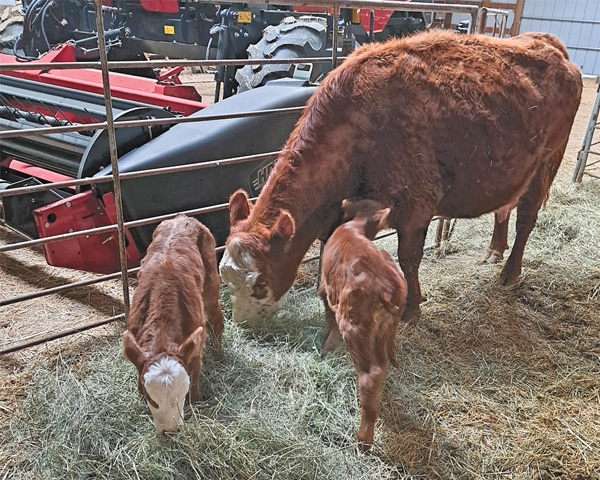Local rancher shares insights as calving season gets underway

M.K. French
Farmer Staff Writer
As calving season progresses in McKenzie County, local rancher Titus Stenberg shares his experiences and insights, highlighting the importance of adaptability, technology, and a deep connection to the land. “My overall experience has been pretty good this year, but it is still early for us,” Stenberg said in a recent interview, noting that his ranch is currently in the first cycle of calving, with about 25 percent of the herd calved out.
Stenberg, a fourth-generation rancher, has been using 100 percent Red Angus bulls exclusively since 2004, a breed he highly praises. “We really like this breed for many reasons: most importantly they have a tame disposition which makes them easy to help when necessary and fun to work with,” he explained. “They generally have good calving ease and an appropriate amount of milk. We like their moderate size and feed efficiency. They are hardy to withstand our winters and adaptable to handle our summers.”
While birth weights and calving ease have been positive this year, Stenberg has observed some challenges with calf vigor. “Calf vigor has been an issue with a handful of calves this year,” he stated. His typical calving practices involve diligent monitoring, especially of first-calf heifers. “We like to check every few hours during daylight, with the first-calf heifers being the first priority,” Stenberg said. “During the night, we will check on the heifers.” He also emphasized the importance of providing extra care for heifers, calving them out 10 days before the main herd and keeping them closer to home.
Facilities and equipment play a crucial role on the ranch. “We have multiple sheds/barns we use during calving season,” Stenberg noted, providing shelter during inclement weather. “For equipment, we use a tractor and 4-wheelers pretty much every day. Other equipment/tools we have on hand to use if/when necessary include: tagger, bander, bottles for bottle-feeding, calf sled, chute with a head catch, calving chains and puller.”
The biggest concern during calving season, Stenberg said, is simple: “The biggest concern is to keep every calf and cow alive. Every day can bring challenges, some predictable, others unpredictable.” But amidst the challenges, there are also significant rewards. “The most rewarding aspect of calving season is seeing healthy calves get the ‘zoomies’ when they put their tail up in the air and run around,” he shared. “Also, when you see a calf that had a rough start nursing or sleeping peacefully next to his mother while she chews her cud.”
This year, the warm and dry weather conditions in the Watford City area have presented unique circumstances. “We have continued to feed hay bales as we’re trying to preserve some pasture due to the dry weather,” Stenberg explained. “Any pasture that gets grazed in these drought conditions puts a lot of stress on the grass and soil.” While the warm temperatures are preferable to extreme cold or blizzards, the dry conditions bring their own issues. “There is a lot of dust blowing around on the windy days,” Stenberg said, adding that they pay extra attention to the cattle’s eyes, nose, and lungs to mitigate potential problems. He also noted that they were able to use trees planted in the 1950s as windbreaks.
Technology has also played a role in Stenberg’s calving management. “Last year, my wife and dad convinced me to invest in calving cameras for the heifers,” he said. “This is our second season with them and they have helped greatly. Having the ability to remotely view the cattle increases efficiency.” He has also had to use the calf warming box for weak or chilled calves and intervene to ensure proper bonding. “Occasionally, we will use ‘Orphan-no-more’ calf claimer powder to encourage the mother to lick its newborn and help the bonding process,” he said.
Stenberg’s experience highlights the importance of knowledge and adaptability. “I feel like I learn stuff every year, and I’m sure I forget stuff every year too,” he reflected. “So much of ranching is following your instincts, sticking to what has worked before and being willing to adapt when necessary.”
Stenberg also emphasized the broader importance of ranching. “Ranching is important in so many aspects,” he said. “Ranchers do their best to take care of their cattle, land and resources. The local and national economy is affected by ranching and what it produces. One eye-opening fact is that, as of January 2025, the United States cattle inventory is at a 64-year low.”
Looking ahead, Stenberg remains optimistic. “I’m expecting the rest of this calving season to go well,” he said, hoping for rain to benefit both ranchers and their herds. His advice to other producers in the region is simple yet profound: “My best advice to other ranchers is to be resilient, trust your gut and give yourself grace. We all make mistakes and sometimes things happen that are out of our control. The key is to learn from those mistakes and do your best.”
Visit www.watfordcitynd.com and subscribe to the McKenzie County Farmer today!
